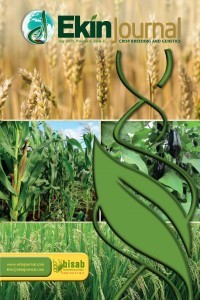Molecular Characterization of Some Triticale Cultivars in Turkey
Molecular Characterization of Some Triticale Cultivars in Turkey
Triticale has gained importance as an alternative crop to solve the nutritional problems of the rapidly increasing world
population. Triticale gains the yield potential of durum wheat and adaptation of rye to cold, drought and marginal soil
conditions in itself. It is also known that triticale is resistant to many diseases and pests. In this study, it was aimed to
determine the genetic characterization of some spring and facultative triticale varieties registered in Turkey with the
ISSR-PCR technique which is one of the molecular marker methods. Polymorphic and monomorphic band images were
formed from 16 primers as a result of analysis of 20 primers in 5 registered triticale isolates, and 71.1% polymorphism
was obtained. Four primers did not show any amplification in the triticale cultivars. Triticale cultivars were mainly
divided into three groups. Alperbey and Tacettinbey which were in the first group, differed by 28% and Mehmetbey
and Ayşehanım in the second group differed by 37%. In addition, EgeYıldızı in the third group differed 48% from Alperbey,
45% from Tacettinbey, 49% from Mehmetbey and 38% from Aysehanım. The genetic distance values between
cultivars of triticale ranged from 0.509 to 0.712. These results obtained from ISSR-PCR method will provide significant
contributions to the triticale breeding programs
Keywords:
Triticale, molecular characterization, polymerase chain reaction, PCR, ISSR Inter-Simple Sequence Repeat,
___
- Çölkesen, M. (1994), et al., "Çukurova ve Harran ovası koşullarına uygun ekmeklik ve makarnalık buğ- day çeşitlerinin saptanması üzerine bir araştırma." Tarla Bitkileri Kongresi : 18-21. Dirik H (1997). "Genetik Çeşitlilik ve Orman Gen Kaynaklarının Korunması," İ.Ü. Orman Fakültesi Dergisi. S113-121. Doyle, J.J., J.L., Doyle. 1987. A Rapid Isolation Procedure for Small Quantities of Fresh Leaf Tissue. Phytochem. Bull. 19:11-15. Hajjar R., Jarvis D.I., Gemmil-Herren B.(2008), "The utility of crop genetic diversity in maintaining ecosystem services", Agriculture Ecosystem and Enviroment. 123: 261-270. Jaccard P. (1912), "The distribution of the flora in the alpine zone," New Phytologist 11(2):37-50 Michelmore, R.W.; Paran, I.; Kesseli, R.V.: "Identification ofmarkers linked to disease genes by bulked segregant analysis: A rapid method to detect markers in specific genomic regions by using segregating populations", Proc. Natl. Acad. Sci., 88 (1991) 9828-9832. Müntzing, Arne (1979). Triticale-Results and problems. Fortschritte der Pflanzenzuechtung (Germany). O’Brien, S.J., (1993), Genetic maps: locus maps of complex genomes, 6th edn. Cold Spring Harbor Laboratory Press, Cold Spring Harbor. Palumbi, Steve (1991). "Simple fool’s guide to PCR" Reddy, M.P., Sarla, N. and Siddiq, E.A., (2002). Inter Simple Sequence Repeat (ISSR) Polymorphism and its Application in Plant Breeding. Euphytica 128:9-17. Varghese, J. P., D. Struss, and M. E. Kazman (1996). Rapid screening of selected European winter wheat varieties and segregating populations for the Glu‐D1dallele using PCR. Plant Breeding 115.6: 451-454. Zietkiewıcz, Ewa, Rafalskı Antoni and Damian Labuda, (1994). Genome finger prinrting by simple sequence repeat (SSR)- Anchored polymerase chain reaction amplification. Genomics, 20(2): 176-183
- ISSN: 2149-1275
- Yayın Aralığı: Yılda 2 Sayı
- Başlangıç: 2015
- Yayıncı: Bitki Islahçıları Alt Birliği
Sayıdaki Diğer Makaleler
Regeneration of Ruta graveolens Transgenic Plants
Molecular Characterization of Some Triticale Cultivars in Turkey
Helicoverpa Resistant Chickpea Plants: From Bt Toxins to Plant-Mediated RNAi
Breeding for Adaptation Traits of Wheat in Eastern European Environments the Hungarian Example
Additional Sources of Resistance for Southern Corn Leaf Blight in Indian Maize Germplasm
